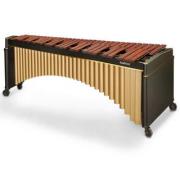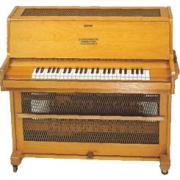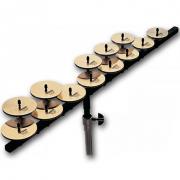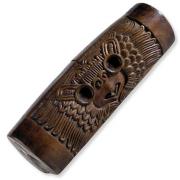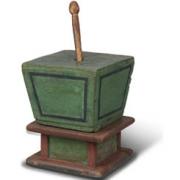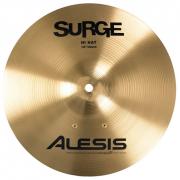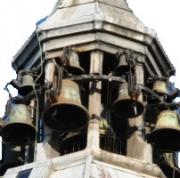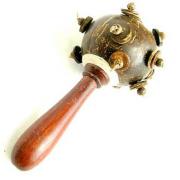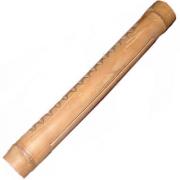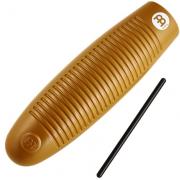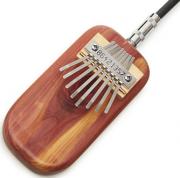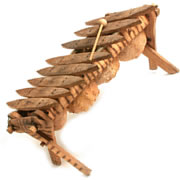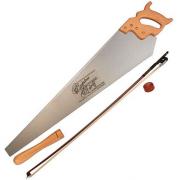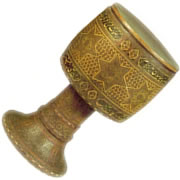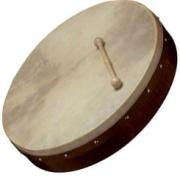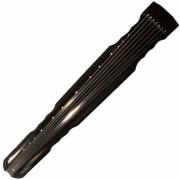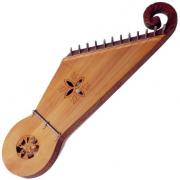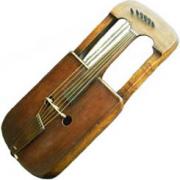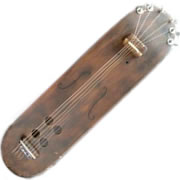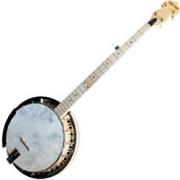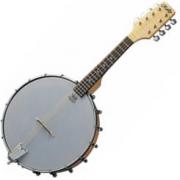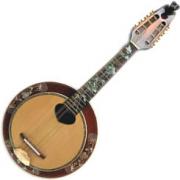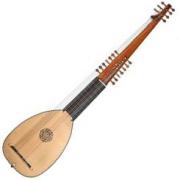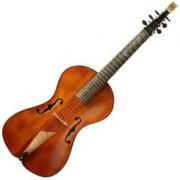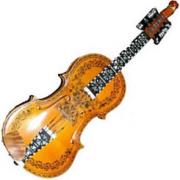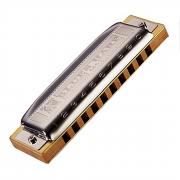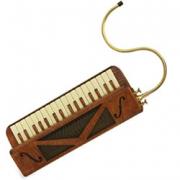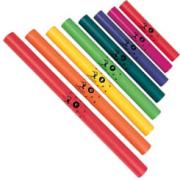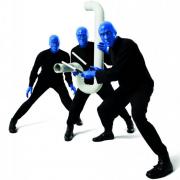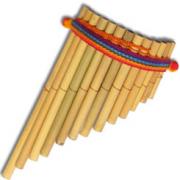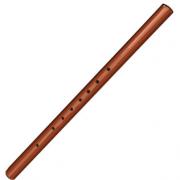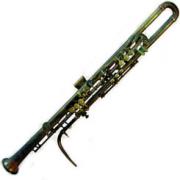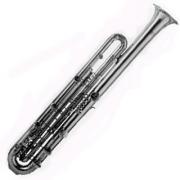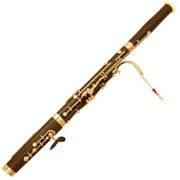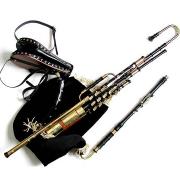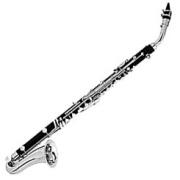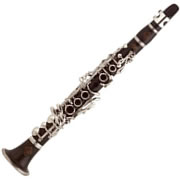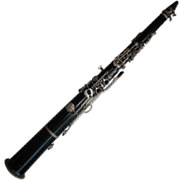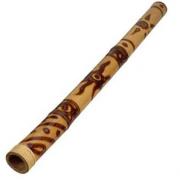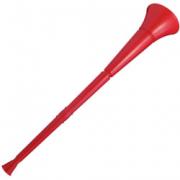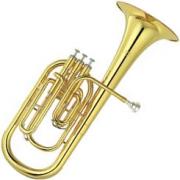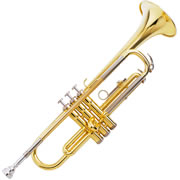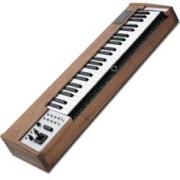Classification of Musical Instruments
ERICH M. VON HORNBOSTEL AND CURT SACHS
Classification of Musical
Instruments
TRANSLATED FROM THE ORIGINAL GERMAN*
BY ANTHONY BAINES AND KLAUS P. WACHSMANN
TRANSLATORS’ PREFACE
The revival of a learned treatisea bout half a century after its first appearancei s
an unusual event, and there must be cogent reasons for taking such a step.
In the present case the reasons are not hard to state. No other system of classification
is more frequently quoted, nor has any later system been able to supplant
it. On these grounds alone it would be difficult to write it off as being
out-of-date.
Apart from the arguments of the system itself, the biting comments on
curators and collectors, and on the waywardness of their cataloguing, are as
relevant today as they were fifty years ago. Reed instruments are still apt to be
labelled as trumpets if the bell is flared-there is a dismal case of this in one of
our great museums at present-and the terminology is still at times as muddled
as it was in the many instances of which Hornbostel and Sachs complained;
while as for anthropologists, their publications do not invariably give proof
that all have read their ZeitschriftifuEr thnologie.
It is true that criticisms have been made, and modifications demanded here
and there; even the authors did not subsequently feel themselves rigidly bound
to what they had first stated in 1914, when they also tried to anticipate those
points over which need for revision was most likely to arise. A good account of
these criticisms has been given in Jaap Kunst’s Ethnomusicolog(y3 rd edn., The
Hague, I959). None of the critics, however, could persuade the present translators
that a return to the original text might involve the undesirable resurrection
of some best-forgotten error. On the contrary, the discussions of the
system’s merits or demerits have convinced them that it is necessary for students
to have easy access to the source itself. This is not meant to imply that the
Hornbostel-Sachs tables are in all circumstances easily applied; one need but
think of some of the many varieties of stamping tubes, e.g. of the slender
‘stamping tubes’ of the Shambala of East Africa, who ‘make slits [in the tubes]
and wave them backwards and forwards while dancing, so that the tongues
are caused to vibrate by atmospheric pressure’ (Hornbostel, 1933, p. 296), or
* Erich M. von Horbostel und Curt Sachs, ‘Systematik der Musikinstrumente.
Ein Versuch’, ZeitschriftifJErt hnologieJ,a hrg. I9I4. Heft 4 u. 5. (Berlin,
I914.) The translators are grateful to Professor Georg Eckert, Editor of the
Zeitschriftf,o r his assent to the work’s republication.
3
of the bamboot ubesw hicht hey strikea gainstt he groundo r drumu ponw ith
twigs; or of the stampingt ubeso f theirn ext-doorn eighbourst,h e Pare,w ho
cover the end of the tube that hits the groundw ith a membraneA. re these
cases of Kontamination(s ee below, paragraph 14) of a basic type ‘stamping
tube’, or is the first a type of free aerophone (41 in the tables), the second a
plosive aerophone (413), the third a percussion idiophone (III.2), and the
fourth a membranophone (2z) of sorts?
The original text did not reach a large musical public since it appeared in the
comparative obscurity of an ethnological journal, while also, being written in
German, it did not become as widely known in the English-speaking world as
it might have done otherwise. Thus there is a clear case for now offering an
English translation.T o do so at this moment will serve also as a fitting memorial
to Professor Curt Sachs, who died in 1959. Posterity can pay no higher tribute
to a scholart han to returnt o his and his collaborator’sw ork and put it into the
hands of a wider public than knew it before. It is in this spirit that the English
translation is published.
The text paragraphs were not numbered in the original. Words in square
bracketsa re the authors’i f German,a nd the translatorsi’f otherwise. The translators’
terminology in the tables takes due account of English terms used by
the authors in their various later publications-as Hornbostel in ‘The Ethnology
of African Sound-Instruments’, Africa, vol. VI (London, 1933), glossary,
pp. 303-II; and Sachsi n The Historyo f MusicalI nstrument(sN ew York, 1940),
‘Terminology’, pp. 454-67. Many of their English terms have come into wide
use, and have been kept save in a few cases where a change (even in one case
to French) seemed to the translators unavoidable or greatly preferable. Most
of the more obscure instruments cited in the tables are described by Sachs in
his Real-Lexikon (Berlin, 1913). Footnotes are original unless stated.
CHORDOPHONES One or more strings are stretched between
fixed points
31 Simple chordophones or zithers The instrument consists solely of a
string bearer, or of a string bearer with a resonator which is
not integral and can be detached without destroying the
sound-producing apparatus
3I Bar zithers The string bearer is bar-shaped; it may be a board placed
edgewise
311.1 Musical bows The string bearer is flexible (and curved)
3II.I Idiochord musical bows The string is cut from the bark of the
cane, remaining attached at each end
311.I111 Mono-idiochord musical bows The bow has one idiochord
string only New Guinea (Sepik R.), Togo
20
311.112 Poly-idiochord musical bows or harp-bows The bow has
several idiochord strings which pass over a toothed stick
or bridge W. Africa (Fan)
311.12 Heterochord musical bows The string is of separate material from
the bearer
311.121 Mono-heterochord musical bows The bow has one heterochord
string only
311.121.I Without resonator NB If a separate, unattached resonator is
used, the specimen belongs to 311.121.21. The human
mouth is not to be taken into account as a resonator
3II.I2I.II Without tuning noose Africa( ganza, samuiust, o)
311.121.12 With tuning noose A fibre noose is passed round the string,
dividing it into two sections
South-equatoriAalf rica( n’kungou, ta)
311.121.2 With resonator
3II.I21.21 With independent resonator Borneo (busoi)
311.121.22 With resonator attached
311.121.221 Without tuning noose S. Africa (hade, thomo)
3 11.121.222 With tuning noose S. Africa,M adagasca(rg ubo,h ungo,b obre)
311.122 Poly-heterochord musical bows The bow has several heterochord
strings
311.122. I Without tuning noose Oceania (kalove)
311.122.2 With tuning noose Oceania (pagolo)
311.2 Stick zithers The string carrier is rigid
311.21 Musical bow cum stick The string bearer has one flexible, curved
end. NB Stick zithers with both ends flexible and curved,
like the Basuto bow, are counted as musical bows India
311.22 (True) stick zithers NB Round sticks which happen to be hollow
by chance do not belong on this account to the tube zithers,
but are round-bar zithers; however, instruments in which a
tubular cavity is employed as a true resonator, like the
modern Mexican harpa, are tube zithers
311.221 With one resonator gourd India (tuila), Celebes (suleppe)
311.222 With several resonator gourds India (vina)
312 Tube zithers The string bearer is a vaulted surface
312.1 Whole-tube zithers The string carrier is a complete tube
312.11 Idiochord (true) tube zithers
Africaa ndI ndonesia(g onra,t ogo,v aliha)
312.12 Heterochord (true) tube zithers
312.121 Without extra resonator S.E. Asia (alligator)
3I2.122 With extra resonator An internode length of bamboo is placed
inside a palm leaf tied in the shape of a bowl Timor
312.2 Half-tube zithers The strings are stretched along the convex surface
of a gutter
312.21 Idiochord half-tube zithers Flores
21
312.22 Heterochord half-tube zithers E. Asia (k’in, koto)
313 Raft zithers The string bearer is composed of canes tied together in
the manner of a raft
313.1 Idiochord raft zithers India,U pperG uinea,C entralC ongo
313.2 Heterochord raft zithers N. Nyasa region
314 Board zithers The string bearer is a board; the ground too is to be
counted as such
314.I True board zithers The plane of the strings is parallel with that of
the string bearer
314.11 Without resonator Borneo
314.12 With resonator
314.12I With resonator bowl The resonator is a fruit shell or similar
object, or an artificially carved equivalent Nyasa region
314.I22 With resonator box (box zither) The resonator is made from
slats Zither,H ackbrettp,i anoforte
314.2 Board zither variations The plane of the strings is at right angles
to the string bearer
314.2I Ground zithers The ground is the string bearer; there is only one
string Malacca, Madagascar
314.22 Harp zithers A board serves as string bearer; there are several
strings and a notched bridge Borneo
315 Trough zithers The strings are stretched across the mouth of a trough
Tanganyika
315.1 Without resonator
315.2 With resonator The trough has a gourd or a similar object attached
to it
316 Frame zithers The strings are stretched across an open frame
3I6.I Without resonator Perhapsa mongstm edievapl salteries
316.2 With resonator W. Africa,a mongstth eK ru (kani)
32 Composite chordophones A string bearer and a resonator are organically
united and cannot be separatedw ithout destroyingt he
instrument
321 Lutes The plane of the strings runs parallel with the sound-table
321.1 Bow lutes [pluriarc] Each string has its own flexible carrier
Africa( akam,k alanguw, ambi)
321.2 Yoke lutes or lyres The strings are attached to a yoke which lies
in the same plane as the sound-table and consists of two
arms and a cross-bar
321.2I Bowl lyres A natural or carved-out bowl serves as the resonator
Lyra, E. African lyre
321.22 Box lyres A built-up wooden box serves as the resonator
Cithara, crwth
321.3 Handle lutes The string bearer is a plain handle. Subsidiary necks,
as e.g. in the Indian prasarini vina are disregarded, as are
also lutes with strings distributed over several necks, like
22
the harpolyrea, nd those like the Lyre-guitars,i n which the
yoke is merely ornamental
321.31 Spike lutes The handle passes diametrically through the resonator
321.311 Spike bowl lutes The resonator consists of a natural or carved-out
bowl Persia, India, Indonesia
321.312 Spike box lutes or spike guitars The resonator is built up from
wood Egypt (rebab)
321.313 Spike tube lutes The handle passes diametrically through the
walls of a tube China, Indochina
321.32 Necked lutes The handle is attached to or carved from the resonator,
like a neck
321.321 Necked bowl lutes Mandolinet, heorbob, alalaika
321.322 Necked box lutes or necked guitars NB Lutes whose body is
built up in the shape of a bowl are classified as bowllutes
Violin, viol, guitar
322 Harps The plane of the strings lies at right angles to the sound-table;
a line joining the lower ends of the strings would point
towards the neck
322.1 Open harps The harp has no pillar
322.II Arched harps The neck curves away from the resonator
Burma and Africa
322.12 Angular harps The neck makes a sharp angle with the resonator
Assyria,A ncientE gypt,A ncientK orea
322.2 Frame harps The harp has a pillar
322.21 Without tuning action All medievahl arps
322.211 Diatonic frame harps
322.212 Chromatic frame harps
322.212.I With the strings in one plane Mosto f the olderc hromatihca rps
322.212.2 With the strings in two planes crossing one another
TheL yon chromatihca rp
322.22 With tuning action The strings can be shortened by mechanical
action
322.221 With manual action The tuning can be altered by hand-levers
Hook harp, dital harp, harpinella
322.222 With pedal action The tuning can be altered by pedals
323 Harp lutes The plane of the strings lies at right angles to the soundtable;
a line joining the lower ends of the strings would be
perpendicular to the neck. Notched bridge
W. Africa (kasso, etc.)
Suffixes for use with any division of this class (chordophones):
-4 sounded by hammers or beaters
-5 sounded with the bare fingers
-6 sounded by plectrum
-7 sounded by bowing
-71 with a bow
23
-72 by a wheel
-73 by a ribbon [Band]
-8 with keyboard
-9 with mechanical drive
![]()


















